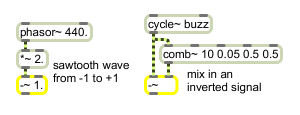Examples

Negative DC offset... Subtraction used to invert a signal before adding it in
Signal subtraction
| Name | Type | Opt | Description |
|---|---|---|---|
| initial-subtraction-value | float or int | opt | Sets an initial amount to subtract from the signal coming into the left inlet. If a signal is connected to the right inlet, the argument is ignored. If no argument is present, and no signal is connected to the right inlet, the initial value is by default. |
| int | input [int] |
In left inlet: Subtracts the signal coming into the right inlet from this value. If a signal is also connected to the left inlet, a or is ignored. In right inlet: An amount to subtract from the signal coming into the left inlet. If a signal is also connected to the right inlet, a or is ignored. |
| float | input [float] |
In left inlet: Subtracts the signal coming into the right inlet from this value. If a signal is also connected to the left inlet, a or is ignored. In right inlet: An amount to subtract from the signal coming into the left inlet. If a signal is also connected to the right inlet, a or is ignored. |
| signal | In left inlet: The signal coming into the right inlet or a constant value received in the right inlet is subtracted from this signal. In right inlet: The signal is subtracted from the signal coming into the left inlet, or a constant value received in the left inlet. |
